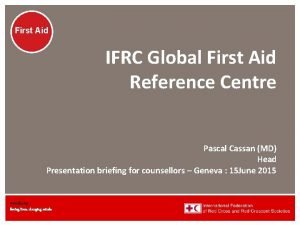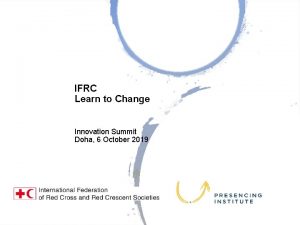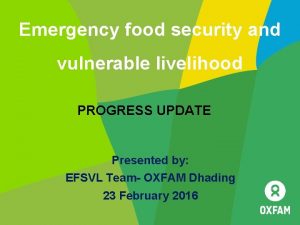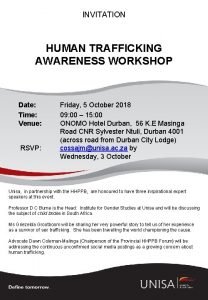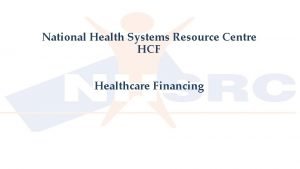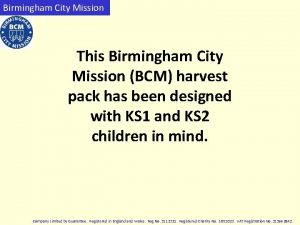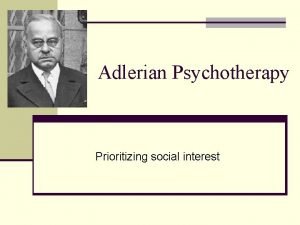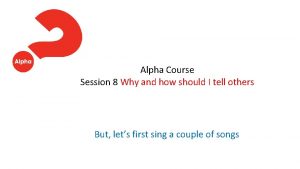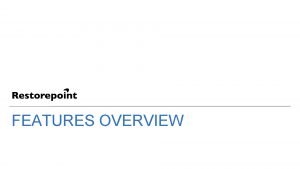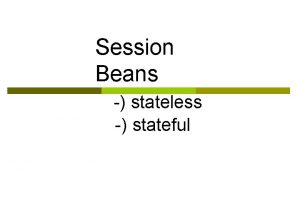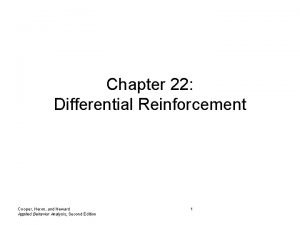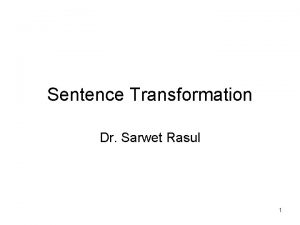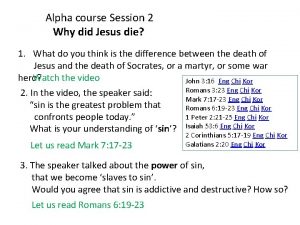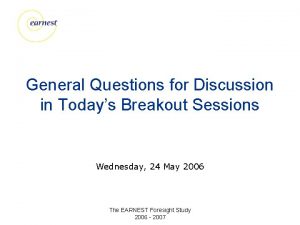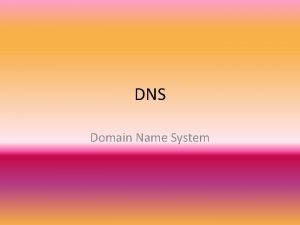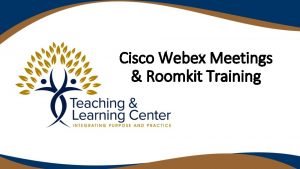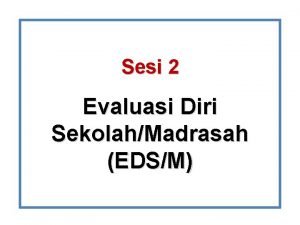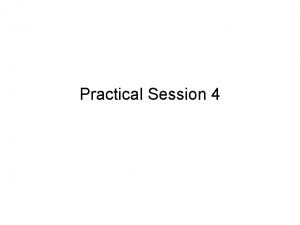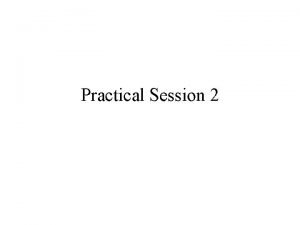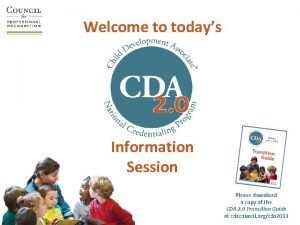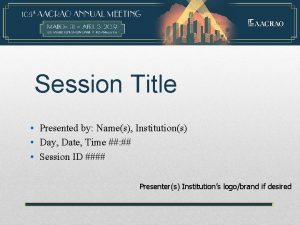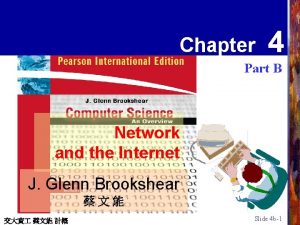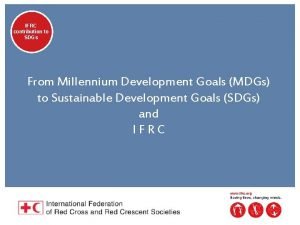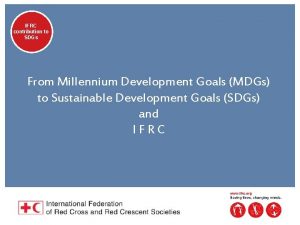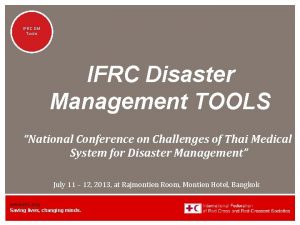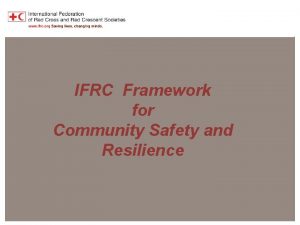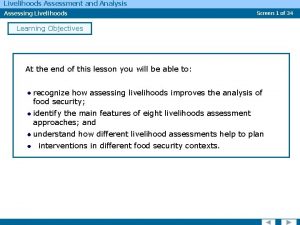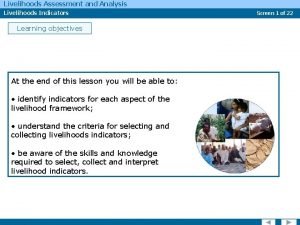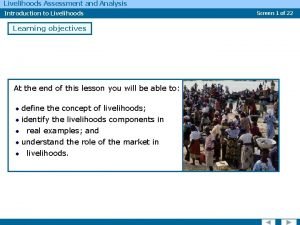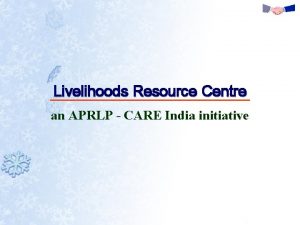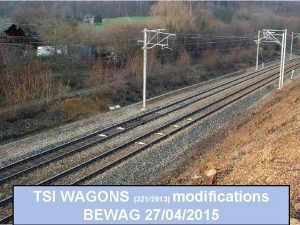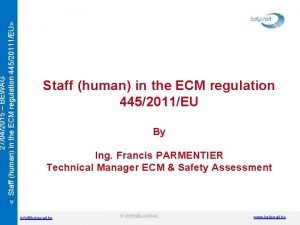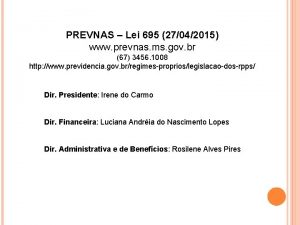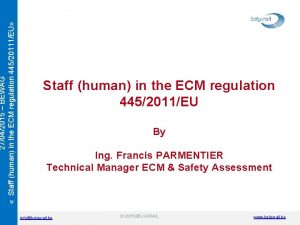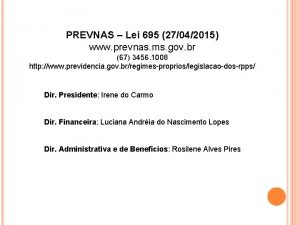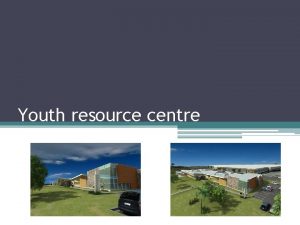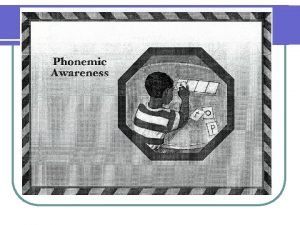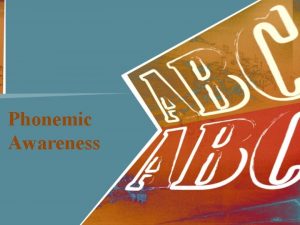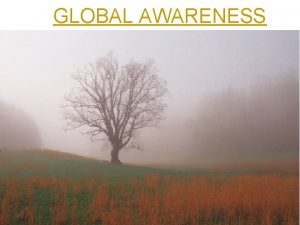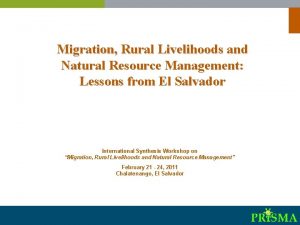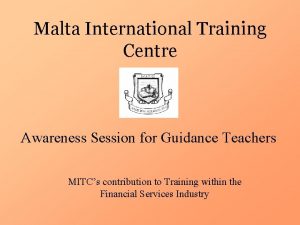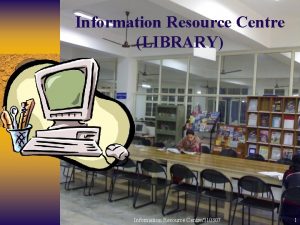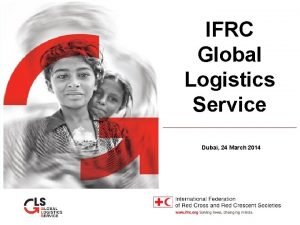Awareness Session IFRC Livelihoods Resource Centre 27042015 Samerang
































- Slides: 32


Awareness Session IFRC Livelihoods Resource Centre 27/04/2015, Samerang: AHA centres DM leaders of tomorrow.

Livelihoods Awareness Session Why Livelihoods? Sustainable livelihoods increase the resilience of the people and the communities, reducing their vulnerability to disasters, food insecurity and poverty while contributing to their empowerment, personal dignity and safer and more resilient communities. A livelihood is also a determinant factor in healthy and safe living and the promotion of social inclusion. Livelihoods support also links directly with the aims of the Millennium Development Goals. The first MDG aims to reduce poverty and hunger. Livelihoods enable vulnerable communities to access basic services and needs. RC/RC Movement Strategic Aims include Livelihoods Objective 1: “Save lives, protect livelihoods, and strengthen recovery from disasters and crises” OXFAM’s Right-Based AIMS: “the right to a sustainable livelihood” includes livelihoods in its Global Goals, and also as one of the five Strategic Objectives “Elimination of poverty and the driving forward of economic and social progress for all, with increased food production, enhanced rural development and sustainable livelihoods” EU Humanitarian Aid continues to focus on building the resilience of populations to better withstand the effects of shocks and stress

Livelihoods Awareness Session Why Livelihoods? ► STRATEGY 2020 OFTHE INTERNATIONAL FEDERATION: Livelihood support links directly with the aims of Strategy 2020, particularly the first aim – “save lives, protect livelihoods, and strengthen recovery from disasters and crises” but encompasses them all. Livelihoods is one of the main components to create RESILIENCE within a Community or a Household.

Livelihoods Awareness Session objectives 1. Understanding what livelihoods are. • • Identify the livelihoods’ assets and resources Have a shared understanding of livelihood concepts, associated terminology and frameworks 2. Understand the overview of the Sustainable Livelihood Framework (SLF). 3. Know why and when provide support to livelihoods. • Understand that livelihood programmes can be implemented as part of relief, recovery and developmental programming aims. 4. Classify different livelihoods programmes into 5 commonly used categories. 5. Provide materials and references on Livelihoods

Livelihoods Awareness Session What are Livelihoods? Livelihoods are ‘the means of making a living’. They are the means for human beings to construct a living and subsist. It is the way in which individuals satisfy their daily needs such as food, shelter, clothing, education and health, amongst other needs. Livelihoods comprise three essential aspects that lead individuals to generate income and secure their subsistence: 1 - the capabilities they have acquired 2 - the assets they posses and have access to 3 - the activities they carry out.

Livelihoods Awareness Session Livelihoods Groups: Are groups of households within a community or geographic zone that share similar assets and capacities through which they gain their means of living. These groups of people are differentiated by the main activity they carry out and the use of their resources to make a living.

Livelihoods Awareness Session Exercise 1 - What is their livelihood?

Livelihoods Awareness Session Assets and Resources Pg. 17 box 3 - IFRC guidelines for livelihoods programming

Livelihoods Awareness Session Livelihoods Strategies Examples of key Programming Aims and Activities under each Asset Group Social Assets Human Assets § Try to build cohesive community, including poorest § Social mobilization to develop community institutions, mediation systems Physical Assets § Improving access to markets, improved infrastructure, clean water § Provide skills and technical training § Increase access to healthcare and education Sustainable livelihoods that are protected from natural disasters § Provide tools and equipment for livelihoods Natural Assets § Grants to improve soil and water resources for agriculture § Environmental security, and development of resources Financial Assets § Grants for livelihoods, debt reduction for poorest, helping set up savings groups and access to credit § Low interest rates, facilitating access to banks

Livelihoods Awareness Session Livelihood outcomes What do people attempt to attain with their livelihoods? What goals do they pursue? Attain better food security Improve dignity and self estime Improve their well being Goals Increase their social relations and status Reduce their vulnerability Increase their income

Livelihoods Awareness Session The Sustainable Livelihood Framework

Livelihoods Awareness Session Coping Strategies These are strategies that individuals carry out when confronted by a difficult situation (i. e. natural disasters, armed conflict, political instability, public economic and social measures amongst others). These consist in adjusting activities, assuming new roles and responsibilities, exploring alternatives to acquisition, the use and sale of their assets, and adapting to change. Gender profiles are important for a full picture of how individuals, households and communities cope in difficult times.

Livelihoods Awareness Session Why provide livelihoods support? In order to facilitate to vulnerable individuals and communities in need, alternatives of means of living, development of personal capabilities and access to opportunities. By ensuring that vulnerable households have sustainable means of living, their incomes, their self esteem, their possession of assets and their social participation will increase significantly over time. Livelihoods support generates a positive impact in the empowerment of individuals, making it possible to make them leaders of their own development.

Livelihoods Awareness Session When is it appropriate to provide livelihoods support? Relief /early recovery In a wide range of disaster and conflict contexts, including sudden onset, slow-onset of chronic situations, as well as complex emergencies. At different stages of people’s lives following a disaster or conflict. Recovery In recovery programmes to move beyond basic relief and support people to return to normal. Development As people go through the stages of recovery, developmental programmes can continue to support vulnerable households even further, beyond recovery. The enabling environment for livelihoods is important in all of these stages, particularly in developmental contexts.

Livelihoods Awareness Session Livelihoods Programming – Appropriateness Appropriate overall programming aims CATEGORIES Type of livelihoods assistance STAGES OF RESPONSE Relief Early recovery Recovery Development 1 Replace livelihood assets 2 Restore livelihood activities 3 Strengthen livelihoods 4 Diversify livelihoods 5 Protect livelihoods Priority aims in most situations Appropriate aims in some situations

Livelihoods Awareness Session Types of livelihoods assistance What? 1. Replacing livelihood assets (page 25 LLH Guidelines) Why? When? Replacing or provisioning with the funds people need to have sources of income and meet immediate basic needs. To save lives and reduce immediate suffering Immediately post-disaster (relief and early recovery) How? (examples): Provision of labour opportunities in labour-intensive cash for-work schemes for activities such as debris clearing. Unconditional cash grant to meet basic needs.

Livelihoods Awareness Session Types of livelihoods assistance

Livelihoods Awareness Session Types of livelihoods assistance What? Why? 2. Restarting / Restoring livelihood activities When? Restarting activities disrupted by disaster or conflict To provide inputs and support in order for people to resume their income-generating activities Immediately post-disaster, and beyond How? (examples): This not standardised and depends on the disasteraffected population in each context. Specific needs of livelihood groups and the interrelation between livelihood groups and the labour & goods market are examined.

Livelihoods Awareness Session Types of livelihoods assistance

Livelihoods Awareness Session Types of livelihoods assistance What? Why? 3. Strengthening livelihoods and use of assets When? Strengthening the use of human and natural assets and resources as well as the coping strategies To improve livelihood outcomes especially economic security and increase resilience to future disasters or conflicts During the early recovery phase and beyond How? (examples): Focus on providing support to improve the quality of physical assets, capacities of individuals, developing skills and techniques, by using better technology, identifying new and improved marketing Methods, market opportunities and routes

Livelihoods Awareness Session Types of livelihoods assistance

Livelihoods Awareness Session Types of livelihoods assistance What? Why? 4. Diversifying livelihoods – not a recommended IFRC aim When? Building on human and natural and financial assets in a way that creates a new window of opportunity for people who belong to a specific livelihood group. To support poorer households to develop new livelihoods strategies and new skills. During the recovery phases, or as development How? (examples): Providing technical & social support and inputs so that additional sustainable livelihoods activities can be pursued to allow them to achieve better livelihood outcomes. Often these are supported through development programming.

Livelihoods Awareness Session Types of livelihoods assistance

Livelihoods Awareness Session Types of livelihoods assistance What? 5. Protecting Livelihoods (contributing to DRR) Protecting livelihood assets, activities and outcomes Why? To ensure people can meet their immediate and ongoing livelihood assets and activities to meet their needs. When? At all times How? (examples): By providing resource transfers in relief and recovery programming stages, in such a way that further productive and financial asset depletion is avoided at household level, and by minimising the negative use of natural, human and social assets that may be irreversible and damaging to livelihoods. Contributing to Disaster Risk Reduction through promotion of more resilient livelihoods.

Livelihoods Awareness Session Types of livelihoods assistance

Livelihoods Awareness Session summary • Livelihood means in simple words ‘means of making a living’. • The main components of the sustainable livelihoods framework are: - Vulnerability context - Policies, institutions and processes - Livelihood outcomes or goals - Livelihood resources or assets - Livelihood strategies • A Household’s vulnerability is determined by its ability to cope with risks and shocks. • People will reply on coping strategies in hard times. • Livelihoods programming can be applied at almost any stage post conflict or disaster and in developmental settings. • IFRC classifies livelihood programmes according to 5 categories linked to 5 different aims: Replace; Restart; Strengthen; Diversify; Protection • All programmes should build on people livelihoods-related capacities.

Livelihoods Awareness Session Livelihoods guidelines, materials and other references § RCRC guidelines, materials, strategies etc. : 2020 Strategy IFRC livelihoods guidelines Global Food Security Assessment Guidelines VAC and VCA Toolbox Research reference Sheets IFRC LRC: www. livelihoodscentre. org § § § Ca. LP: www. learningcash. org and the Cash Atlas Oversees Development Institute: http: //www. odi. org/events Humanitarian Practice Network: http: //www. odihpn. org ALNAP: http: //www. alnap. org IASC, Gender Handbook in Humanitarian Action, Women, Girls, Boys and Men Different Needs – Equal Opportunities § DFID Sustainable Livelihoods Guidance Notes § FEWS NET: www. fews. net § EMMA (Emergency Market Mapping Assessment): http: //emmatoolkit. org/get/

Livelihoods Awareness Session Key issues! • Livelihoods in all phases (emergency, recovery, development) Livelihoods programming and support can be provided in a developmental setting as well as in a wide range of disaster and conflict contexts. • Livelihoods can be addressed in all different types of emergencies Including sudden onset (i. e. : earthquakes, floods, hurricanes), slow-onset or chronic situations (i. e. : drought) as well as complex emergencies where populations suffer the effects of a natural disaster event alongside conflict.

Livelihoods Awareness Session Any questions?

Livelihoods Awareness Session THANK YOU!

 Gender based violence
Gender based violence Global first aid reference centre
Global first aid reference centre Learn to change ifrc
Learn to change ifrc Emergency food security and vulnerable livelihoods
Emergency food security and vulnerable livelihoods Perbedaan icrc dan ifrc
Perbedaan icrc dan ifrc Date, time venue invitation
Date, time venue invitation Privacy awareness and hipaa privacy training cvs answers
Privacy awareness and hipaa privacy training cvs answers Perbedaan resource loading dan resource leveling
Perbedaan resource loading dan resource leveling Resource leveling is the approach to even out the peaks of
Resource leveling is the approach to even out the peaks of National health systems resource centre
National health systems resource centre Mission ltd birmingham
Mission ltd birmingham Centre of gravity of different shapes
Centre of gravity of different shapes Center of gravity statics
Center of gravity statics Adlerian therapy
Adlerian therapy Alpha session 2
Alpha session 2 Network configuration backup
Network configuration backup Stateful session bean example
Stateful session bean example Dra in aba
Dra in aba Cosmos db cap theorem
Cosmos db cap theorem Transform in a sentence
Transform in a sentence Alpha why did jesus die
Alpha why did jesus die Fordham lincoln center campus map
Fordham lincoln center campus map Breakout session questions
Breakout session questions Dns session
Dns session Breakout rooms on webex
Breakout rooms on webex Evaluation session
Evaluation session Practical session meaning
Practical session meaning Session aims
Session aims Multipicand
Multipicand Couche session
Couche session Welcome to today's session
Welcome to today's session 6 session name
6 session name Tcp segment structure
Tcp segment structure

